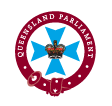-
Visit and learn
- Message from the Speaker
-
About Us
- A day in the Life of the Queensland Parliament
- The Executive Government of Queensland
- Officers of the Queensland Parliament
- The Origins of the Queensland Parliament
- The Queensland Parliament and Parliamentary Process
-
Parliamentary Scrutiny via Parliamentary Committees
- The Queensland Parliament and the Financial Process
- The Queensland Parliament and the Legislative Process
- The Queensland Constitution
- The Queensland Electoral System
- The Role of Parliament
- Separation of Powers
- Learn About Parliament
- Information For
- Visitors
- Visit the Public Gallery
- Visit our Gift Shop
- Have Your Say
- Get Involved
- Education and Learning
- History
- Heritage Collections
- Preservation of our Heritage
- Regional Sittings
- CPA Australia and Pacific Regional Conference
- Publications and Reports
- Speakers' Corner
- Opening of the 58th Parliament
- Parliamentary Annexe Reparation and Refurbishment
- Contact Us
Parliamentary committees
A more detailed form of scrutiny involves the Parliamentary committees. Evolving from the 16th century in the British Parliament, committees consisting of parliamentarians were established to perform functions or investigate matters which were either too complex or too technical for the normal routine of parliamentary business. Today, parliamentary committees in the Queensland Parliament are involved in a wide range of duties including - the examination of legislation and regulations, the scrutiny of Government expenditure, the oversight of a range of independent bodies, the operations of parliamentary procedures, and the investigation of any issue into which the Parliament may require a detailed inquiry. As investigative bodies, parliamentary committees are able to summon and examine witnesses, canvass public opinion, subpoena documents and papers, evaluate the evidence gathered and compile a report for the Parliament, usually with a range of recommendations.Former parliamentary committees
Until September 1995, there were three types of Parliamentary Committees operating in the Queensland Parliament - standing, select and statutory. Standing committees, appointed for the life of the Parliament either by Standing Orders, Sessional Orders or resolutions of the House, were the time-honoured committees which mainly dealt with parliamentary operations and included the Printing Committee, the Privileges Committee and the Standing Orders Committee. Select committees can still be constituted and are usually appointed to investigate a particular matter and cease to exist after their final report to the Parliament, e.g., the Select Committee into Ambulance Services. Other select committees, e.g., the Travelsafe Committee, which inquired, reported and made recommendations on all aspects of Queensland road safety, were reconstituted for the life of each Parliament.
A more recent phenomenon involves statutory committees. These are parliamentary committees established by and operating under their own legislation, but still comprising parliamentary Members. In 1988-1989, following a considerable period of pressure, the Ahern National Party Government instituted a Public Accounts Committee (PAC) and a Public Works Committee (PWC). Two further committees were also established as a result of recommendations from the Fitzgerald inquiry into police and public sector corruption - the Parliamentary Criminal Justice Committee (PCJC), now known as the Parliamentary Crime and Corruption Committee (PCCC), and the Parliamentary Electoral and Administrative Review Committee (PEARC). Further committees were created by legislation in 1995.
Since 2011, the Parliament has adopted a system of portfolio committees. In Queensland, most parliamentary committees are established permanently by legislation, usually the Parliament of Queensland Act 2001.
The size of membership of a portfolio committee and the balance of Members between Government and non-Government Members is based on formulae set out in the Parliament of Queensland Act 2001 and depends on the political composition of the Legislative Assembly at the time. The Chair of a portfolio committee is nominated by the Leader of the House.
The Parliament will occasionally establish additional temporary committees to inquire into specific ‘select’ issues. These temporary committees are called ‘select committees’.
The Committees comprise representatives from all of the political parties, with the Chairperson either the Speaker or a Government Member. The operations and recommendations of Parliamentary Committees should reflect a non-political approach. However, this does not prevent Members from disagreeing with a Committee's findings or even issuing a minority report.
As mentioned, in The Queensland Parliament and the Financial Process, the portfolio committees and the Committee of the Legislative Assembly examine the Government's annual Budget by scrutinising the proposed expenditures of each department along with the Parliamentary Service, the Governor's Office, statutory agencies and Government Owned Corporations, and then report their findings to the Parliament.
For a more detailed description of Parliamentary Committees and their current Membership -
See Also - Queensland Parliament - Parliamentary Committees
See Also - Factsheet 3.9
